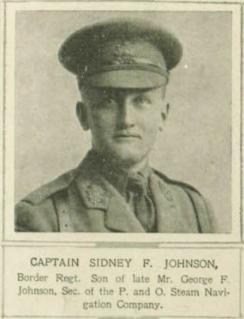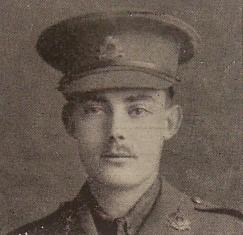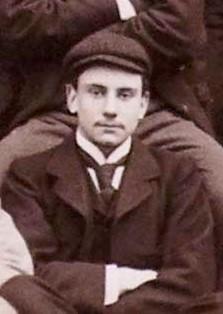Jacobs, Derek, brother of Bryan Sydney Jacobs (qv); b. 20 Dec. 1917; adm. Sept. 1931 (A); left Dec. 1932; a cane merchant; PO RAFVR Oct. 1941, killed in action Dec. 1941.
Derek Jacobs was born at Brighton, Sussex on the 20th of December 1917 the son of Sydney Jacob, a gentleman, and Ella Bonham (nee Collins) Jacobs of “Rosebriars”, 441, Woodham Lane, West Byfleet in Surrey. He was educated at Westminster School where he was up Ashburnham from September 1931 to December 1932.
On leaving school he worked as a traveller for a general merchant. He enlisted in the Royal Air Force Volunteer Reserve where he trained as a Wireless Operator/Air Gunner and rose to the rank of Sergeant before being commissioned as a Pilot Officer on the 31st of October 1941.
On the night of the 7th/8th of December 1941, Bomber Command dispatched 130 aircraft for an operation on Aachen. The headquarters building of the local Nazi party was to be used as the aiming point for the bombers. Weather conditions were difficult with only 64 aircraft having claimed to have dropped their bombs on the target. The Aachen railway goods yards were hit by three bombs during the raid with 7 houses being slightly damaged. There were no casualties on the ground.
Derek Jacobs and his crew took off from RAF Scampton at 2.13am on the 8th of December 1941 in Hampden Mk I AE191 OL-Z for the operation. It was to be his sixth operation. Having dropped its bombs the aircraft was leaving the target area at a height of 17,000 feet when it was hit in the port engine by anti aircraft fire. Derek Jacobs was instructed by the pilot to send an SOS call and received a “fix” from RAF Heston. With flames coming from the damaged engine Anthony Parsons, the pilot, throttled the engine back and stopped the propeller, in an attempt to let the fire extinguisher put the fire out. When the fire was extinguished, but with only one engine still working, the aircraft began to yaw and was in danger of entering a flat spin. In order to prevent this Parsons shut down the starboard engine and stabilised the stricken bomber but, when he attempted to restart it, it failed. The crew had made two radio distress calls, one at 5.30am and the second at 6.08am, before they were forced to ditch in the North Sea near Walcheren Island at 6.40am.
Air Sea Rescue boats were dispatched to look for them but found no trace of the missing aircraft and its crew.
The crew was: -
Sergeant Bernard Athelstan Basevi (Observer)
Pilot Officer Derek Jacobs (Wireless Operator/Air Gunner)
Pilot Officer Anthony Leslie Parsons (Pilot) (POW No. 39646 Stalag Luft III)
Sergeant George Wiscombe (Air Gunner) (POW No. 24785 Stalag Luft III)
The four members of the crew had all managed to climb into the dinghy but it was four days before they were rescued, during which time Bernard Basevi died from cold and exposure during the night of the 10th of December and was buried at sea the next morning. Derek Jacobs died on the 11th of December and the two surviving crew members also buried him at sea. The two survivors were picked up by a German convoy escort ship “Wuppertal”, some 15 miles to the south west of Heligoland at 1.45pm the following day and were taken to Cuxhaven Military Hospital where they were treated for frost bite and exposure.
His father received the following letter dated the 23rd of December 1941: -
“Sir, I am commanded by the Air Council to express to you their great regret on learning that your son, Pilot Officer Derek Jacobs, Royal Air Force, is missing as the result of air operations. Your son was wireless operator/air gunner of a Hampden aircraft which set out at 2.13am for action over Aachen, Germany, and has failed to return. Two wireless signals were received from the aircraft, one at 5.30am and the second, an S.O.S. call, at 6.08am. The Air/Sea Rescue Services were put into operation and searching continued throughout the day, but no trace could be found of any of the crew. Enquiries will now be made through the International Red Cross Society and if any news is received you will be at once informed. If any information regarding your son is received by you from any source you are requested to be kind enough to communicate it immediately to the Air Ministry. The Air Council desire me to convey to you an expression of their sincere sympathy with you in your present anxiety.”
George Wiscombe wrote the following to his wife from prisoner of war camp in a letter dated the 16th of January 1943: - “..... engine trouble made us crash in the sea, the four of us getting away in the rubber dinghy unhurt apart from shock ..... Navigator Basevi died the third night and Jacobs as you know the following day. Saw land on morning of fifth day but were blown away soon after. P/O Parsons and myself picked up by German boat after 104 hours afloat. Treated very well and taken into Cuxhaven Military Hospital.”
Anthony Parsons wrote the following letter to the Air Ministry from Dulag Luft dated the 3rd of May 1942: -
“Dear Madam, I regret to say that P/O Jacobs, 112160, died on the night of Dec. 11th 1941 from shock, exposure and lack of fresh water. Sgt. Basevi passed away through the same causes, the previous night. They both died quietly and without pain, being unwounded. Please convey my sympathies to their families, and say that I did the little that I could for them, without avail.”
Theirs was one of two aircraft lost during the raid.
He is commemorated on the Runnymede Memorial Panel 33.



